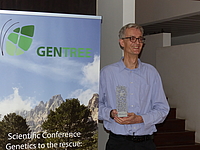Have you ever looked at trees in autumn and wondered why some of them still have green leaves, some have turned red or yellow and still others are already completely bare? Or maybe, after a hard winter or hot summer, you asked why this plant survived and that one died? Well, that is what I do for living!
I am one of the many European scientists working in the GenTree project to understand the heritable differences among different forest trees as a way to improve the sustainable use forest genetic resources in Europe.
As a biologist, I know that some of the differences that we see among individuals are the result of the environment. Maybe this specific plant was subject to violent gusts of wind. Maybe it did not get enough water. Maybe it was attacked by herbivores. All these could cause visible differences among individuals and even the death of some.
But as an evolutionary geneticist, I am also aware that just as all the people on earth (except identical twins) have different DNA, so do trees. It is the genetic variation in the trees’ DNA that I am particularly interested in.
There are two broad types of evidence of genetic variation: phenotypic and genotypic. The phenotype is the combination of an organism’s observable characteristics, determined partly by the genes and partly by the environment. Further, genes and environment interact. So one tree may be more drought-resistant than another, but unless there is actually a drought, there may be no visible difference between them. Genotypic variation these days is often assessed by DNA sequencing, which reveals genetic differences among individuals. In our research, we try to assess both at the same time.
To separate the phenotypic variation caused by genetic differences from that caused by the environment, we need to minimise environmental variation. Then only the genetic differences will matter. With forest trees, we do this by growing plants in what we call common garden experiments. This simply means that we grow seedlings of potentially different genetic origins in the same location, trying to keep the conditions as similar as possible for all of them.

Tanja Pyhäjärvi, PhD, is an Academy Research Fellow at University of Oulu, Finland. She studies plant evolutionary genomics and is particularly interested in conifers and other plants with large and complex genomes. In semester 2018-2019, she is a visiting scientist at the University of Minnesota.

The picture shows a common garden experiment at the University of Oulu in Finland. As part of GenTree we sowed Scots pine seedlings from different European geographic origins next to each other in the same field in Spring 2017.
Even after only a few weeks, differences started to emerge among seedlings from different genetic backgrounds. The first row on the left is a family of Finnish seedlings while the seedlings in the row on the right are from a Spanish family. You can see clearly that the Finnish seedlings are shorter and darker in colour; because the two rows are growing in the same environment these phenotypic differences must reflect genetic differences.
The experiment is being replicated with thousands of seedlings across European locations in Finland, Germany, Lithuania and Spain. At the end we will be able to tell how much of the differences among families and geographical origins is the result of underlying genetic differences. The experiment will also inform us about the role of genetics in the early survival of forest trees in different environmental conditions.
In the future, we will also delve into the molecular part of the genetic variation. We can compare molecular variation of trees from different geographical regions with environmental conditions, such as the length of the growing season or the average annual temperature. In this way, we can identify patterns in DNA-level variation that are related to adaptation to different local habitats.
In the end, we hope to be able to put all the data – on environment, phenotype and molecular variation – together so that practitioners can take evidence-based decisions on how to manage European forests.


